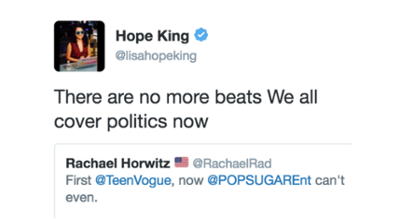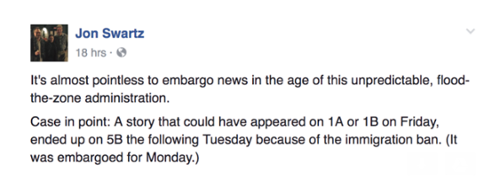Webinar: How to Navigate PR in This Shifting Communications Landscape
Feb 07, 2017 admin
We’re only a month into the new year and a lot has has changed for our industry — indeed, just since Inauguration Day. The media, business and geopolitical landscape is shifting under our feet so quickly that we at InkHouse wanted to share our point of view on what is happening and how it could impact any communications strategy right now.First, let’s look at the state of the news media. It all comes down to four new terms: "post-truth era," #fakenews, "alternative facts" and alt-Twitter handles. None of this is good for PR. In fact, it’s so bad that the Public Relations Society of America recently issued a statement about how it’s our job to tell the truth, not obfuscate it. Of course, we agree wholeheartedly and view the media as our partner, not an adversary.
Meanwhile, consumers of information are more skeptical about what they’re reading and more polarized than ever about what outlets they choose to read. We’re all immune to shocking headlines, making it easy to overlook what used to stand for hard news, and overwhelmed with the amount of information (I just used air-quotes) that is jamming social feeds.
The media is preoccupied with one story: Trump. Investigative journalism and leaks are gaining traction. But reporters who cover almost any beat -- the environment, healthcare, education, law, business, real estate, technology, arts, the economy, cybersecurity -- heck, even footwear! -- have been sucked into the Washington vortex.
Brands and CEOs are being drawn in as well, either by accident or by design: Tesla, Starbucks, Google, Apple, Uber, Lyft, Budweiser, Lockheed Martin, Ford Motor Co., TripAdvisor and New Balance are among the list of companies facing unexpected political news or responding to it.
How does all of this affect your business, your organization, your campaign, your PR and marketing goals? See for yourself.

Sure, we are in a challenging PR environment, one in which you need experienced, calm, innovative counsel to help guide you through it. There’s no room for mistakes, especially since (as we wrote in this Boston Globe op-ed) brands are the new battleground states. If you believe in what you’re doing or saying, it may be hard, but you’re authentic — and that’s what matters right now.
So here are some guidelines through which you should review your communications strategy:
- Be safe. Update your crisis and social media escalation plans given the current state of affairs. Do you know what to do in case of a consumer boycott? What about a tweet from @POTUS? And if there should be an information leak or breach? If you don’t have a plan, get one fast. Have a stable of holding statements for the media and social channels for any scenario you can imagine. Don’t forget, anything you put in email can be made public.
- Be adaptable. If your best laid strategy and tactics aren’t working because the news cycle is too short or too crowded for you to be heard, be willing to pivot. In order to breakthrough today, your story needs to be relevant to the world at large or hyper-focused to resonate with a particular audience. This does not mean you should be talking politics, per se. But it should be clear why you matter right now.

- Be ready. Let’s call this scenario planning for storytelling — creating a nimble infrastructure for evolving the message in real time. Develop canned stories or responses for almost any situation because you won’t have days to wordsmith or approve the messaging. Our world is instantaneous.
- Be trustworthy. Audiences are skeptical and exhausted. They want facts. Do you have data? If so, mine it for bullet-proof stories or find external data that can be used to create an even better story.
- Be digital-first. President Trump did this during the campaign, prioritizing Facebook and Twitter over TV and print. Clearly, it worked! This approach can involve taking paid social media targeting and messaging to an Olympic level.
- Be more visual. Video and images will matter more to cut through information clutter. For example, Facebook recently announced updates to its news feed algorithm to boost longer videos. Also consider new storytelling tools, such as virtual or augmented reality and data visualization.
- Be mindful of internal communication. During uncertain times, it may feel safer to keep quiet about political issues. But good leaders will ensure employees are informed, focused and engaged at work. What is your internal communications plan? Are you addressing questions at staff meetings about health care changes, the economy, immigration changes, business travel? Are you drafting a written statement or FAQ for workers?
If you have a strong communications plan, great. But in such a fluid environment, keep gut-checking it based on the day’s developments. This is PR, version 2017.
To discuss this further, please join our webinar on Thursday, 12 p.m. EST: "PR in the Post-Truth Era." During this webinar, we'll review how the current media and political environment affects your business, your organization, your campaign and your PR and marketing goals and share guidelines through which you should review your communications strategy.
Please register via this link. We hope you can join us.






